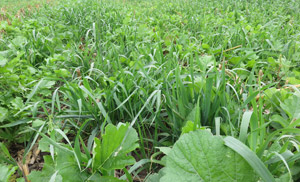Producer Question from 2015
Q: I am planning on grazing cover crops (double cropped forage) this fall should I be concerned about nitrates? (November 4, 2015)
 A: Some of the species of cover crops that are commonly used which have the potential for nitrate accumulation include: brassicas (turnips/radishes/collards, etc.), corn, millet, oats, cereal rye, sorghums and sorghum x sudangrass hybrids, and sunflower.
A: Some of the species of cover crops that are commonly used which have the potential for nitrate accumulation include: brassicas (turnips/radishes/collards, etc.), corn, millet, oats, cereal rye, sorghums and sorghum x sudangrass hybrids, and sunflower.
Nitrate concentrations usually are higher in young plants and decrease as the plant matures. Cover crops planted in July or early August following wheat may be less problematic than those that follow corn silage. Nitrates can be a potential issue even in non-accumulator species if the plants are immature.
The risk of nitrate toxicity increases when nitrogen (N) availability is high. Hybrid seed corn fields or hail-damaged corn fields are a concern regardless of the species planted because large amounts of N may still be available for the cover crop.
Many cover crop mixtures often have several species known to accumulate nitrates. Fields with excessive N remaining from previous crop or those with high rates of additional N applied to stimulate cover crop growth can result in high nitrate potential. So can plants that have been drought stressed or exposed to any other growing condition that slows plant growth. In these cases, it is a good idea to test forages for nitrates before grazing begins.
How to take samples
When obtaining samples, the producer should walk in a random zig-zag pattern over the whole field and hand pluck a small area down to the height at which you intend to graze from about 20 locations. This process is similar to obtaining a good soil sample. The enzyme and bacterial activity in fresh forage samples can reduce the nitrate level. Thus, samples should be placed in plastic bags and immediately put in a cooler on ice or ice packs.
It is recommended to deliver samples directly to the lab or freeze the samples for 24 hours prior to shipping and ship in an insulated container. Also, avoid shipments late in the week to avoid delayed arrival to the lab.
What to do once you have the results
Current levels of risk are based on hay feeding (Table 1). Potential for nitrate toxicity is lower in grazed forage than in hay with the same level of nitrate due to several factors:
- Grazing animals eat more gradually than those receiving hay.
- When cattle are grazing they tend to be selective and don't graze the entire field close to the ground (where nitrate is highest).
However, grazing cover crops that contain elevated nitrate concentrations is not without risk.
| Table 1. Risk of forages with various levels of nitrates | |
|---|---|
| Level in Forage (Dry Basis) Nitrate Nitrogen (NO3-N), ppm |
Risk for Un-adapted Animals |
| 0-1100 | Safe |
| 1100-2100 | Moderate Risk |
| 2100-3400 | High Risk |
| >3400 | Severe Risk |
| Labs vary in the way they report nitrate levels. To convert nitrate ion (NO3-) to Nitrate N X by 4.43. To convert percent (%) to ppm multiply by 10,000. | |
How to use moderate or moderately high nitrate cover crops (1000-3400 ppm Nitrate N)
Make sure cattle are full before putting them on fields. Regardless of the nitrate level, a good management practice is to fill cattle up with hay before turn-out.
Use lower risk cattle, if possible. The group with the greatest risk of negative consequences due to feeding of high nitrates forages is pregnant cows, as abortion can result. Open cows are the best option followed by growing calves (stockers or developing replacement heifers before breeding).
Gradual adaptation can be used as a strategy to minimize risk. Animal adaptation is a key management strategy for using high nitrate forages. Losses from nitrate toxicity will be much greater in cattle not adapted to nitrate. The bacteria in the rumen capable of degrading nitrite to ammonia for bacterial protein synthesis will increase in numbers when nitrate is available to them. Adapted animals can safely be fed higher levels. To adapt the cattle, start by grazing the lowest-nitrate fields and then work up to the highest.
Graze higher N fields lightly to allow animals to selectively graze plant parts that are lower in nitrate concentration. Nitrate level varies with location in the plant. Nitrate tends to accumulate in the lower stem, so overgrazing so that cattle have to eat the lower stem can cause increased intake of nitrate.
Consider grain supplementation while adapting cattle to high nitrate lower quality forages such as mature sorghum x sudangrass hybrids or pearl millet. This will supply energy for rumen microbes to convert nitrate into bacterial protein and minimizes the intermediate nitrite production. Brassicas, such as turnips and radishes are very highly digestible and as such may be providing enough energy to allow for increased microbial protein synthesis. Thus, grain feeding may be of limited benefit for high quality cover crops.
Summary
Grazing cover crops that contain moderate to moderately high nitrate concentrations is not without risk, but these cover crops can be grazed successfully. Use the management practices mentioned above to reduce the chance of animal loss. Extensive losses can occur when non-acclimated, hungry cattle are put out on moderate to moderately high nitrate forages.
If high levels are detected (> 3400 ppm Nitrate-N), the safest alternative is to not use them and allow these high nitrate crops to remain as traditional cover crops.
Mary Drewnoski,
Beef Systems Specialist
Daren Redfearn,
Forage and Crop Residue Systems Specialist